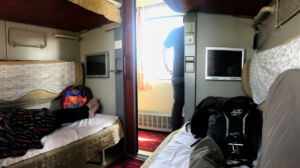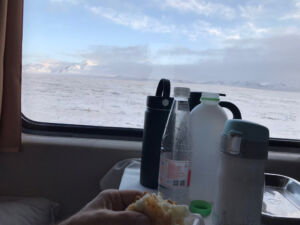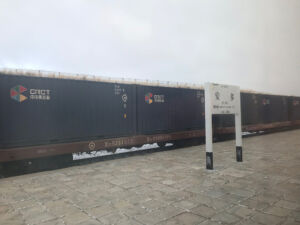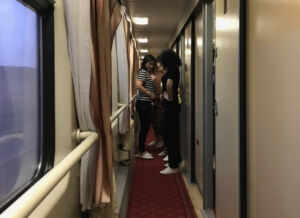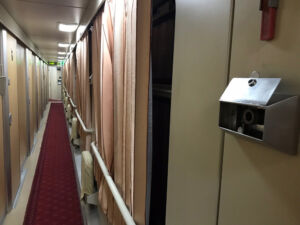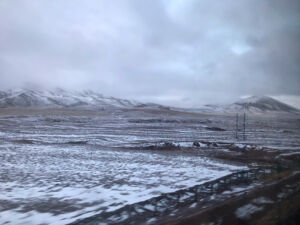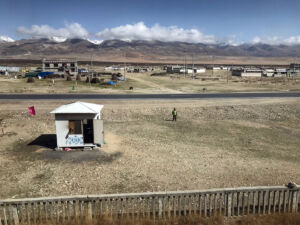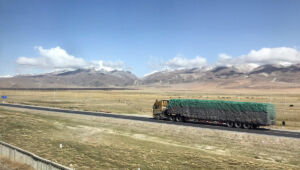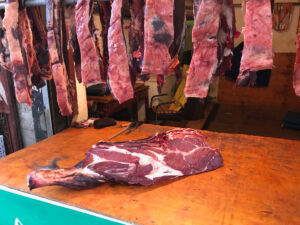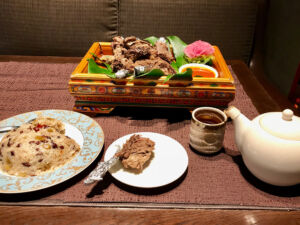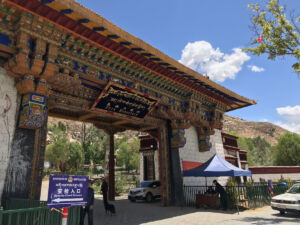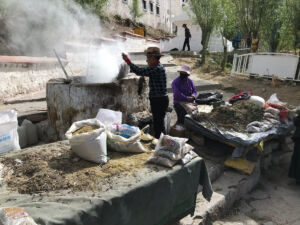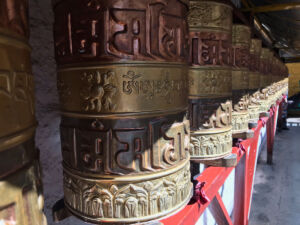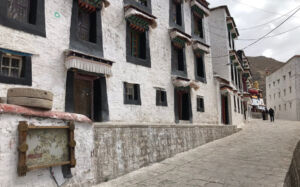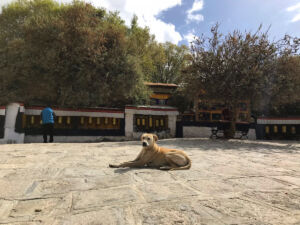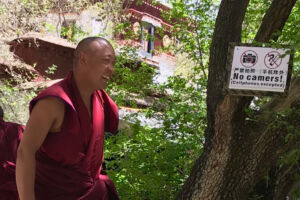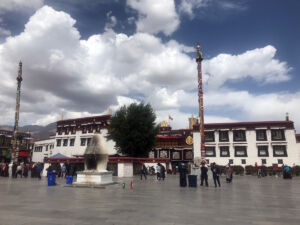Journey to Lhasa and the Roof of the World
Lhasa and the world-famous Potala Palace marks the final destination on my quest to see all the sites depicted on the back of the Chinese bank notes (the Palace is on the 50-yuan bill). What started as a fun personal goal ended very well as Lhasa and Tibet are certainly at the top of my list of favorite places.
Tibet is called the “roof of the world” for good reason as the plateau rises sharply with an average height of 4500 meters above sea level and covers an area of over 2.5-million square kilometers. It’s a huge, elevated landmass in Central Asia and traveling there presents a few interesting challenges.
The biggest challenge is the altitude where the air is 30% thinner which can cause pretty bad mountain sickness. Another challenge is getting permission from the Chinese government for the privilege of visiting. Foreigners may only travel during certain times of the year and can be denied for any reason. Furthermore, you cannot go to many places alone nor visit wherever you please. In other words, for me at least, there were a few restrictions. However, with a little bit of planning and going with a tour agent, the trip can be smooth and super enjoyable. I had a great time and this journey to the “roof of the world” was mind opening and rewarding in many ways.
My Itinerary and Some Tips
Days 1-3
I decided to first fly into Xining to look around and start acclimatizing to higher elevations. Coming from sea level, 2200 meters is a good start because it’s not too high yet you’ll feel the effects slightly. While in Xining I took a day-trip to Zhangye to see the “Rainbow Mountains”.
Day 4
Go to the Xining train station for the Qinghai–Tibet train. It’s an overnight journey leaving around 15:20 in the afternoon and arrive in Lhasa the next day about 12:20 noontime.
Days 5-8
I meet with the local guide and joined up with a group. The guided tour took us to the main attractions as described below. Days started at 9:00 and finished around 15:00. This was great because each day I had plenty of time to wander around the city exploring. The last day was hotel checkout then catch an airplane in the afternoon.
Tips
- Try to visit between May and September. The weather is warmer, crowd level better and it’s easier to get a permit.
- Double-check that you are not traveling during a holiday or special event otherwise the crowds may be too much.
- The altitude is a real concern and the better fitness level you have the easier it’ll be to manage.
- A headache is common for about a day or so. Drink enough that you go to the bathroom frequently, avoid alcohol, and take it easy.
- Pack like you would for any vacation and bring a light jacket, even in the summer, because evenings get chilly.
- Due to the political situation, avoid any religious or political topic no matter who you are with. Just don’t.
- Visiting Tibet and Lhasa is an amazing and life-changing experience so don’t sweat it, relax and have a great journey.
Qinghai – Tibet Railway
The train ride from Xining to Lhasa took about 22-hours on an overnight train along the amazing Qinghai–Tibet Railway. Luckily I booked a soft-sleeper cabin that I shared with three other passengers. It was cozy and my bunkmates were very friendly. One was an Ayi going to visit her parents in Lhasa and she was very nice. Around dinner time she offered everyone some snacks of cucumber, bread (发面饼), and sausages.
After leaving Xining station, the elevation quickly went up as the train ascended the Tibetan Plateau. Sometime after midnight, we made it to the Tanggula Pass at over 5000 meters high. I think this where I awoke from my sleep with a stinging headache!
Here are some notes about the train ride:
- Lots of tunnels early on; Some are very long and the cell phone coverage is so spotty it’s near useless
- Soft sleeper is quite comfortable and you gotta accept your situation on a public train with new friends close by
- The train is a bit aged and worn although not bad
- The dining car has full kitchen making normal Chinese meals which looked delicious
- Tip: bring lots of 1-dollar US bills to sell. People may want them as souvenirs
- Bring snacks to share with your bunkmates
- Slippers for getting out of bed and walking around
- You will probably get a headache from the altitude and Excedrin worked great for me


Lhasa
Lhasa (ལྷ་ས་; 拉萨; Lāsà) is the capital city of Tibet Autonomous Region and sits at 3646 meters above sea level. In the Tibetan language, Lhasa means the Holy Land or Land of the Buddha and it is the cultural center of Tibet. The famous Potala Palace with its iconic red and white colors is easy to spot as it soars above the city. About twenty minutes walk from the palace is Barkhor Street which encircles the Jokhang Temple.

Potala Palace
As the train arrived in Lhasa, the first thing I looked for was The Potala Palace. It’s easy to spot sitting atop a large rock hill that’s right in the middle of the city. Potala Palace was the residence of the Dalai Lama until the 14th went to India during the 1959 Tibetan uprising. Today, the palace is a museum and World Heritage Site open to the public.
Inside the palace is just as amazing as outside but photos are strictly forbidden although you may find a book in the giftshop. Most of the rooms are small and you feel like you are wandering through a maze but some open up into cavernous halls. For me, the most interesting was the hall containing the remains of the 5th Dalai Lama and others. There’s simply so much to take in and see that you probably will not understand it in a first visit. I soaked up as much as I could and hopefully can match a memory with later readings and discussions.
Jokhang Temple and Barkhor Street
The Jokhang Temple isn’t nearly as big as The Potala Palace but don’t let that color your understanding of its importance. For as my guide said, Jokhang Temple, which means the house of Buddha, is the epicenter of Tibetan Buddhist culture. Inside is the statue of Buddha-Jowo Rinpoche which was personally blessed by the Buddha. Therefore the statue and temple have become the spiritual center of Tibet and the holiest destination for all Tibetan pilgrims.
Jokhang Temple is situated in the heart of the old town and is surrounded by Barkhor Street. Nearly any given day pilgrims, and tourist circumnavigate the street in a clockwise fashion to pay worship and receive blessings. Most people go around the temple in a sort of walking meditation while others will prostrate themselves which is quite interesting to see.
Barkhor Street and the surrounding area is densely packed with shops and markets. Along Barkhor street is mainly souvenirs and trinkets, but off street in the neighborhood are a plethora of markets, crafts shops, and restaurants. To take it easy and wander around exploring is supremely rewarding here. I spent hours meandering through the maze of narrow streets and alleyways.

Drepung Monastery and Sera Monastery
Two famous monasteries in Lhasa are Drepung and Sera. Drepung seemed a bit more organized and clean while Sera was messy mostly due to construction. I learned most of the monasteries were severely vandalized during the cultural revolution and later reconstructed in the 1980s.
Sera Monastery was built in 1419 and houses many precious relics and scriptures for monks to learn Buddhist knowledge. Additionally, Sera is well known for Tibetan Buddhism debating where monks test their mastery of Buddhist knowledge and philosophy.


There were a lot of photos for this post and the gallery below is split into two pages. Click on the “dot” to go to the next page.
Here is a short video. Within is a speeded-up clip of me circumnavigating Barkhor Street. It’s something you gotta do when visiting.





